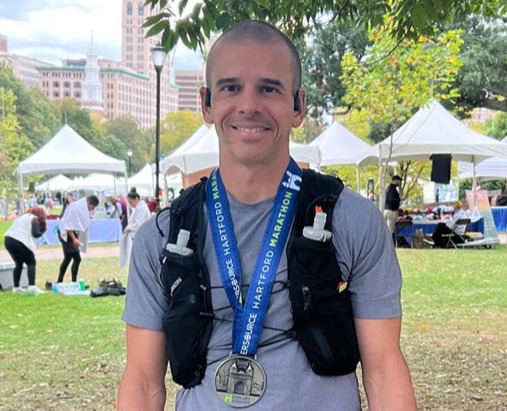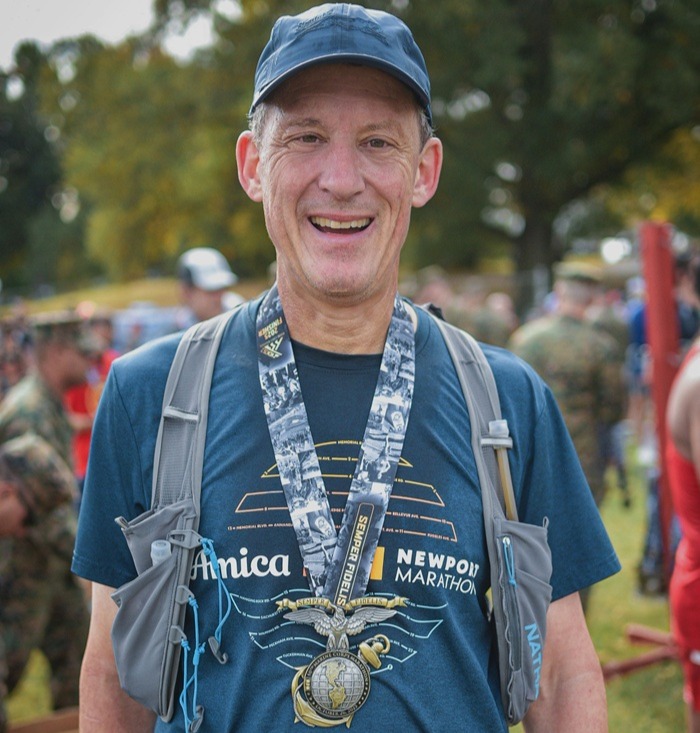Two Physicians, One Goal: Lessons from the Marathon Journey
Dr. Codispoti and Dr. Benthien share insights from their marathon journeys to inspire runners of all levels

Running a marathon is never just about putting one foot in front of the other. It is about determination, planning, and understanding your body. For Dr. Vincent Codispoti, an Interventional Physiatrist and Spine Specialist, and Dr. Ross Benthien, a Foot and Ankle Specialist, both physicians at Orthopedic Associates of Hartford, the road to the marathon has been as much about personal growth as it has been about fitness. They hope the lessons learned during their marathon journeys can also benefit their patients.
Finding Motivation and Overcoming Challenges

For Dr. Codispoti, running became part of his life during recovery from a significant surgery. “During my recovery, a couple of my friends were running half marathons, and I thought, wouldn’t it be something to train and run a half marathon after recuperating from surgery?” he recalls. What started as a personal challenge quickly grew into a passion, and running has since become a central part of his exercise routine. In October 2025, he completed his first full marathon, the Hartford Marathon, a milestone that reflects his steady commitment to health and perseverance.
Dr. Benthien’s running journey started much earlier in life. “I can’t really remember not running,” he says. Growing up in Washington State, he competed in track and cross-country in middle and high school, and later ran the Marine Corps Marathon during his medical school years. “Running became a way to clear my head, stay in shape, and challenge myself. Over the years, it’s just become part of who I am.” He’s completed numerous marathons and races across the country, making running a lifelong pursuit that continues to shape his views on endurance and patient care.

Both physicians credit their past experiences and understanding of their bodies with guiding their approach to training. “I’ve had a couple of freakish injuries over the last few years,” Dr. Codispoti says. “Only one was running-related, but it’s made me really conscious about pacing myself and monitoring my body carefully.”
Dr. Benthien echoes this caution. “I’ve learned to listen to my body over time,” he notes. “Even with decades of experience, I pay attention to subtle signals, tightness in a tendon or foot, and I adjust before it becomes a problem. That’s a skill everyone can develop.”
Structuring Training and Balancing Life
Training for a marathon is as much about strategy as it is about stamina. For Dr. Codispoti, as a first-time marathoner, a structured program has been key. “I follow a beginner-friendly training plan, which is basically plug-and-play for first timers. Four days of running a week, a day of short strength training, and rest days. It’s about modifying as I go and listening to my body.”
Dr. Benthien, a seasoned runner, incorporates a higher volume of runs and has experimented with different training philosophies. “Currently, I am following a structured marathon training plan that emphasizes running six days a week. The idea is to run while slightly fatigued to build endurance. It’s definitely different from what I’ve done in the past, but it’s been effective.”
Both doctors acknowledge the difficulty of balancing training with busy professional and personal lives. “I have a full-time practice and a family,” Dr. Codispoti notes. “It’s been a challenge, but setting realistic goals and sticking to a schedule has helped.”
Dr. Benthien adds, “Even with decades of running experience, life can throw you off. I am a member of running groups, and I use fitness apps to keep myself accountable. Seeing others’ progress motivates me and helps me structure my own training.”
The Mental Game
Marathon running is as mental as it is physical. Dr. Codispoti identifies fear of setbacks as a major hurdle. “I constantly monitor for anything that might prevent me from reaching the finish line, injuries, you name it. It’s about finding the balance between pushing forward and staying safe.”
Dr. Benthien emphasizes the joy of running itself as motivation. “Sometimes it’s a chore, sometimes it’s freeing. Running lets me explore places I wouldn’t otherwise see, from along the Salzach River in Austria to the narrow streets in Venice, and every neighborhood in my town. There’s a sense of discovery and adventure that’s hard to replicate.”
Both physicians stress that mental fortitude comes from persistence and self-awareness. “You learn how to do hard things,” Dr. Benthien says. “Running has taught me perseverance, and that carries over into everything I do, from work to life in general.”
Dr. Codispoti reflects, “Even as a novice, I’ve learned that persistence and willpower matter just as much as physical preparation. Overcoming fear and showing up consistently has been a huge part of my journey.”
Injury Prevention and Recovery
Maintaining health is essential for consistent training. Dr. Codispoti emphasizes stretching and warming up before his runs. “I spend about 15 minutes stretching before my long runs and do some mild cardio to get my heart rate up,” he says. Post-run recovery is equally important; cooling down, stretching, and replenishing electrolytes and carbohydrates are part of his routine.
Dr. Benthien adds that proactive hydration, fueling, and dynamic stretching have helped him avoid injuries over decades of running. “I pay attention to how my feet, ankles, and tendons feel. If something’s off, I adjust my gait or take a break. Beginners often make the mistake of doing too much too soon. It’s better to start gradually and build up.”
Both doctors note that the principles of injury prevention apply to runners of all levels. Dr. Codispoti says, “You need to respect your body’s limits. Overtraining can set you back for weeks, so pacing yourself is crucial.” Dr. Benthien adds, “Even small adjustments, like hydration, stretching, or recovery days, can make a huge difference in staying healthy long-term.”
Advice for Patients and Runners
Their combined experience offers lessons for runners of all levels:
Start gradually: Walk before you run, and consider shorter races before attempting longer distances.
Listen to your body: Modify training as needed to prevent injury.
Hydrate and fuel properly: Pay attention to nutrition before, during, and after runs.
Stay motivated: Joining running groups, using apps, or setting personal goals can help maintain consistency and enjoyment.
Dr. Codispoti adds, “Anyone can take on a physical challenge if they start slow, build gradually, and continue to challenge themselves safely.” Dr. Benthien reflects, “Running teaches resilience and changes the way you see yourself. It’s both a physical and mental journey.”
Lessons Learned
For both doctors, running has been about more than finishing races.
“I’ve learned to respect my limits, recover properly, and still challenge myself,” says Dr. Codispoti. “It’s empowering to see what your body can do when you prepare and listen to it.”
Dr. Benthien agrees. “Running has shown me the power of mental strength, the importance of staying determined, and the joy of discovering something new, both around me and within myself.”
Their journeys demonstrate that with careful preparation, patience, and persistence, runners of any level can achieve their goals while keeping their health a top priority.